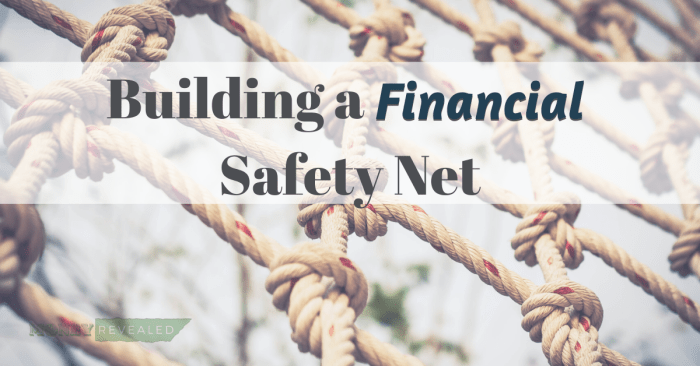Yo, diving into Building a financial safety net, this intro sets the stage for a dope discussion on why having a solid financial safety net is key. From protecting you during emergencies to ensuring your financial stability, we’re about to break it down for you.
Now, let’s get into the nitty-gritty details of what makes up a robust financial safety net and how you can start building one from scratch.
Importance of Building a Financial Safety Net
Having a financial safety net is crucial for individuals to prepare for unexpected situations that may arise.
Protection During Emergencies
- During a medical emergency, a financial safety net can cover unexpected medical expenses not covered by insurance.
- In the event of a job loss, having savings can help cover daily expenses until a new job is secured.
- If your car breaks down or your house needs repairs, a safety net can prevent financial strain.
Beneficial Unforeseen Circumstances
- Unexpected home repairs due to natural disasters or accidents can be covered by a financial safety net.
- Facing a sudden need to travel for a family emergency can be less stressful when there are savings to rely on.
- Being able to handle unexpected costs like replacing an essential appliance without going into debt.
Components of a Financial Safety Net
Building a strong financial safety net involves several key components that work together to protect you in times of need. Let’s break down the essential elements that make up a solid safety net.
Emergency Savings
Emergency savings play a crucial role in a financial safety net by providing a buffer against unexpected expenses or loss of income. These funds should ideally cover 3-6 months’ worth of living expenses to help you weather any financial storms that come your way.
Insurance
Insurance is another vital component of financial planning that can help protect you from significant financial losses due to accidents, illnesses, or other unforeseen events. Whether it’s health insurance, auto insurance, or homeowners insurance, having the right coverage can provide peace of mind and financial security.
Investments
Investments can also play a role in building a financial safety net by helping you grow your wealth over time. By diversifying your investment portfolio and focusing on long-term growth, you can create a source of additional income that can support you during emergencies or retirement.
Strategies for Building a Financial Safety Net
Building a financial safety net from scratch can seem daunting, but with the right strategies, it is achievable. By implementing smart saving techniques and diversifying your assets, you can create a robust safety net to protect yourself from unexpected financial emergencies.
Start Small and Consistent
One of the best ways to start building a financial safety net is by saving consistently, even if it’s a small amount. Set aside a portion of your income each month and make it a priority to contribute to your savings account. Over time, these small contributions will add up and help you build a solid foundation for your safety net.
Automate Your Savings
To make saving easier, consider setting up automatic transfers from your checking account to your savings account. This way, you won’t even have to think about saving – it will happen automatically. By automating your savings, you can ensure that you consistently contribute to your safety net without having to actively remember to do so.
Diversify Your Investments
Another key strategy for building a financial safety net is diversifying your investments. Instead of putting all your money into one type of asset, consider spreading it across different investment vehicles such as stocks, bonds, real estate, and savings accounts. Diversification can help protect your wealth from market fluctuations and economic downturns, ensuring that you have a more stable safety net.
Maintaining and Growing Your Financial Safety Net

Maintaining and growing your financial safety net is essential for long-term financial security. By regularly updating and reassessing your safety net, you can ensure that you are prepared for any unexpected financial challenges that may arise.
Regularly Update Your Safety Net
- Review your budget and expenses on a monthly basis to identify any changes or areas where you can cut back on spending.
- Adjust your emergency fund savings goal based on any changes in your income, expenses, or financial goals.
- Update your insurance coverage to ensure that you are adequately protected in case of emergencies or unforeseen events.
- Monitor your investments and retirement accounts to make sure they are aligned with your long-term financial goals.
Strategies for Growing Your Safety Net
- Increase your emergency fund savings by setting aside a portion of your income each month.
- Explore additional income streams such as freelancing, part-time work, or passive income opportunities.
- Invest in assets that can generate passive income, such as rental properties or dividend-paying stocks.
- Consider automating your savings and investments to ensure consistent growth over time.
Reassess Based on Changing Circumstances
- Regularly review your financial goals and adjust your safety net accordingly.
- Update your emergency fund savings goal as your expenses or income change.
- Reevaluate your insurance coverage to make sure it still meets your needs and provides adequate protection.
- Adjust your investment strategy based on changes in the market or your risk tolerance.